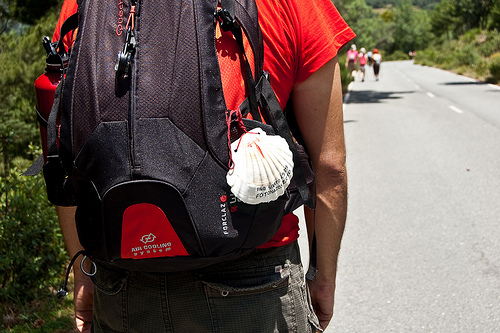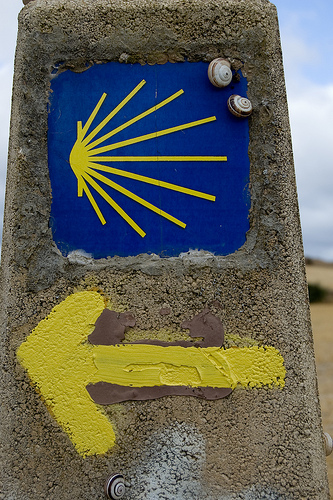
We previously described how we managed to get a 90 day Schengen tourist visa and the main purpose for applying for such a long visa – the Camino de Santiago de Compostela.

Typical pilgrim on the Camino
The Camino, as it is more famously known, is a series of walking trails that start in many parts of Europe and which end in the Spanish town of Santiago. It’s possible to walk as little or as much of the Camino as you like, but a popular part of the walk is from the town of St Jean Pied-de-Port in southern France. This leg of the journey is about 750km in length and takes between 30 and 35 to complete.
Over the past 1000 years or so this walk has been completed by Catholics as a pilgrimage to the burial place of St. James. In more recent times, people other than Catholics have made the pilgrimage. Although it seems strange, the walk has become somewhat of a favourite among those wanting to travel Europe on the cheap, those searching for spiritual enlightenment, people wanting to find themselves, people wanting to lose weight and those that simply don’t know why they want to walk it — they just want to walk.
To be honest, we don’t know why we want to walk it. We’re not Catholic, so we’re not doing it for religious reasons. Maybe it just suits our style of travel — slow, cheap, experiential travel. And who knows, we may just have a spiritual awakening.
The first day of the walk climbs up over the Pyrenees Mountains and into Spain. From then on it’s 30 days of walking where the average distance covered per day is 25km with all your possessions on your back. This means you have to pack light — some recommend 10% of your body weight in your pack which is not much! A change of clothes, a pair of flip flops, some basic toiletries, your passport, a wallet, a camera, a phone… not much else.
The path is marked for the entire length by the symbol of the Camino — a scallop shell. This symbol guides walkers (or pilgrims, as they are more commonly known) in the right direction and helps find the right path which can be difficult at times.

The way to Santiago is marked by a scallop shell
Prior to commencing the walk, pilgrims pick up an official pilgrim’s passport from the Camino office of their departure point. Every night, pilgrims receive a stamp in this passport verifying that they have in fact stayed in a particular town. Upon arriving at Santiago, pilgrims present the passport to the Camino office where a certificate is produced which states that you have completed the Camino. Pretty cool yeah?

The Camino passport is an important part of the journey
The great thing about this walk is that all along the route there are places to stay called refugios and albergues. They’re basically simple forms of accommodation that are extremely cheap. A bed in a dorm, a blanket and a shared toilet all for about €6 per night — it’s almost impossible to find accommodation this cheap anywhere else in Europe!
We plan to write a new blog post every single day that we are on the Camino. We plan to enter Europe at the end of July and we will keep you updated from then on. So don’t forget to check in regularly to see what happens next on our journey through Europe. You can also follow our hashtags on twitter #EuropeDulu and #CaminoDulu.
And if you’re looking for some more inspiration, check out this fantastic video!
Photos licensed under creative commons licence from jexweber.fotos and gabsiq.


Good luck, Adam & Susan! I can’t wait to read your story here 😀
Have fun there and take care!! 🙂
Have fun for ur journey trip kak! Kmarin malam ak jg liat Camino, di film The Way. Stamp passport nya unik! 🙂
have a nice trip adam and susan 😉
ohh sounds interesting and the camino passport, I want to have one!!!!
Hope I can try this walk also in one or two years from now 😉
Have fun there and dont forget to share your stories! <3